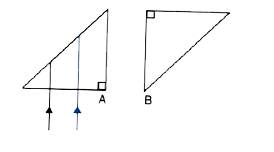Two small angled prisms A and B deviate the blue rays by 7∘ and 9∘ and the red rays by 5∘ and 7∘ respectively. Which prism has a greater dispersive power?
To determine which prism has a greater dispersive power, we can use the formula for dispersive power (ω):
ω=Angular DispersionMean Deviation
Step 1: Calculate the dispersive power for prism A
1. Identify the angular deviations for prism A:
- Blue rays: 7∘
- Red rays: 5∘
2. Calculate the angular dispersion for prism A:
Angular Dispersion (A)=Deviation for blue−Deviation for red=7∘−5∘=2∘
3. Calculate the mean deviation for prism A:
Mean Deviation (A)=Deviation for blue+Deviation for red2=7∘+5∘2=12∘2=6∘
4. Calculate the dispersive power for prism A:
ωA=Angular Dispersion (A)Mean Deviation (A)=2∘6∘=13≈0.33
Step 2: Calculate the dispersive power for prism B
1. Identify the angular deviations for prism B:
- Blue rays: 9∘
- Red rays: 7∘
2. Calculate the angular dispersion for prism B:
Angular Dispersion (B)=Deviation for blue−Deviation for red=9∘−7∘=2∘
3. Calculate the mean deviation for prism B:
Mean Deviation (B)=Deviation for blue+Deviation for red2=9∘+7∘2=16∘2=8∘
4. Calculate the dispersive power for prism B:
ωB=Angular Dispersion (B)Mean Deviation (B)=2∘8∘=14=0.25
Step 3: Compare the dispersive powers
- Dispersive power of prism A: 0.33
- Dispersive power of prism B: 0.25
Conclusion
Since 0.33>0.25, prism A has a greater dispersive power than prism B.
---
- Blue rays: 7∘
- Red rays: 5∘
Angular Dispersion (A)=Deviation for blue−Deviation for red=7∘−5∘=2∘
Mean Deviation (A)=Deviation for blue+Deviation for red2=7∘+5∘2=12∘2=6∘
ωA=Angular Dispersion (A)Mean Deviation (A)=2∘6∘=13≈0.33
- Blue rays: 9∘
- Red rays: 7∘
Angular Dispersion (B)=Deviation for blue−Deviation for red=9∘−7∘=2∘
Mean Deviation (B)=Deviation for blue+Deviation for red2=9∘+7∘2=16∘2=8∘
ωB=Angular Dispersion (B)Mean Deviation (B)=2∘8∘=14=0.25
- Dispersive power of prism B: 0.25
Topper's Solved these Questions
- BOOK - AAKASH SERIESCHAPTER - RAY OPTICSEXERCISE - PROBLEMS ( LEVEL-I)57videos
RAY OPTICS
- BOOK - AAKASH SERIESCHAPTER - PRACTICAL PHYSICSEXERCISE - LECTURE SHEET LEVEL-II (ADVANCED) Linked Comprehension Type Questions4videos
PRACTICAL PHYSICS
- BOOK - AAKASH SERIESCHAPTER - SEMICONDUCTOR DEVICESEXERCISE - EXERCISE - III3videos
SEMICONDUCTOR DEVICES
Similar Questions
Two small angled prisms A and B deviate the blue rays by 6∘ and 8∘ and the red rays by 4∘ and 6∘ respectively. Which prism has a greater dispersive power ?
View SolutionA prism of a certain angle deviates the red and blue rays by 8∘ and 12∘ respectively. Another prism of the same angle deviates the red and blue rays by 10∘ and 14∘ respectively. The prisms are small angled and made of different materials. The dispersive powers of the materials of the prisms are in the ratio
View SolutionSuppose a small angled prism of 6∘ deviates a ray through 3∘, then the refractive index is
View SolutionCompare the dispersive powers of two prisms if one of them deviates the blue and red rays through 10∘ and 6∘ respectively and the second prism through 8∘ and 4.5∘
View SolutionTwo prisms A and B are in contact with each other have angular dispersions of 2∘ and 4∘ respectively. The dispersive power of A is 0.002. If the combination produces dispersion without deviation, the dispersive power of B is
View SolutionThe minimum deviations suffered by red, yellow and violet beam passing through an equilateral transparent prism are 38.4∘,38.7∘ and 39.2∘ respectively. Calculate the dispersive power of the medium.
View Solution(a) Figure shows two isosceles right angled prisms A and B and the light rays incident on the prism A. complete the diagram to show the rays emerging out of the prism B.
(b) State the principle used for completing the ray diagram in part (a) above.
 View Solution
View SolutionFlint glass prism is joined by a crown glass prism to produce dispersion without deviation. The refractive indices of these for mean rays are 1.602 and 1.500 respectively. Angle of prism of flint prism is 10∘, then the angle of prism for crown prism will be
View SolutionTwo prisms A and B have dispersive powers of 0.012 and 0.018 respectively. The two prisms are in contact with each other. The prism A produces a mean deviation of 1.2∘, the mean deviation produced by B if the combination is achromatic is
View SolutionThe deviation caused for red, yellow and violet colours for crown glass prism are 2.84∘,3.28∘ and 3.72∘ respectively. The dispersive power of prism material is:
View Solution

